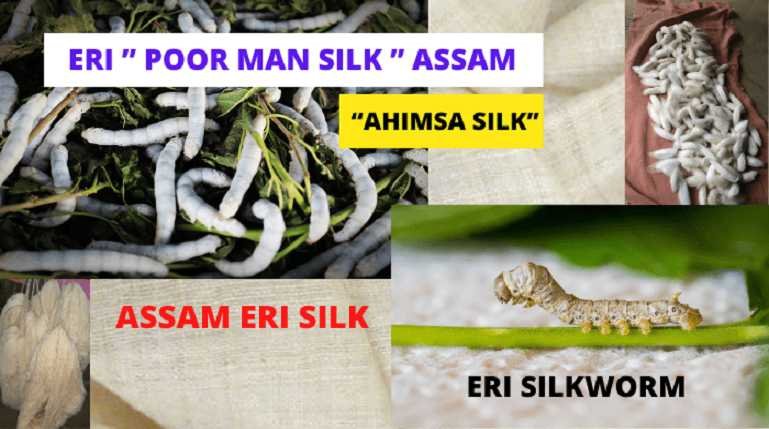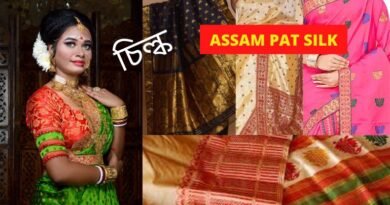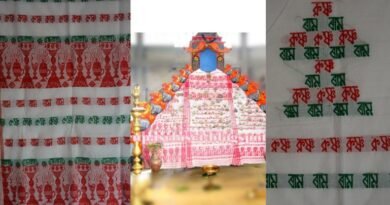ASSAM ERI SILK- POOR MAN SILK – AHIMSA SILK
ERI ” POOR MAN SILK ” ASSAM
INTRODUCTION
Muga Silk is taken into account as the king of silk, however there’s one other indigenous worm silk extensively accessible in Assam. This is Eri silk, thought of to be poor man’s silk, however it’s intently connected to the assamese society, costume for it’s heat high quality.
The fascination in the direction of eri garments among the many people of Assam and the North-east can simply be gauged from an outdated Assamese proverb (“dair paani, erir kaani”) which suggests that whereas curd cools the eri dress warms up an individual (Allen 1899:10).
ORIGIN & SCIENTIFIC NAME
The name “Eri” is derived from an assamese phrase “Era” the castor plant. One of the widespread names, the ‘Ailanthus Silk moth’, refers back to the host plant. . Eri silk is also referred to as endi or errandi in India. This initially wild silk-moth in India, the Eri Silkmoth (Samia ricini)is now absolutely domesticated and used primarily within the north east parts of the nation. The earliest reference to Eri silk tradition in India is documented in 1779, and Eri silk was lengthy known as “Assam silk”. The wooly white silk is sometimes called the Ahimsa silk or the material of peace as the method doesn’t contain the killing of the silk worm. After the Moths leave the cocoon the empty cocoon is spun. The eri silk worm is the one fully domesticated silkworm apart from Bombyx mori.
Eri threads are extracted from Eri worm , like some other silk extraction. The scientific identify of the Eri worm is Samia Ricini. This worm shouldn’t be wild as Muga, completes the entire life cycle at dwelling solely.The identify ‘Eri’ has advanced from ‘Era’ plant (Cator Plant) which is known as ‘Eranda’ in Sanskrit. This plant is foremost meal for the Eri worm and usually present in these crops solely.
PRODUCTION PROCESS
The larvae feed primarily on leaves of Castor (Ricinus communis ), however have plenty of alternate host crops equivalent to Kesseru (Heteropanax fragrans), Cassava or Topioca (Manihot exculata) and some different crops species.
Eri silk cocoons can’t be reeled since the cocoons are collected solely after the moth emerges out, leaving a gap within the cocoon, that breaks the continuity of the silk filament. The cocoons are subsequently subjected to spinning both by hand (tuckly) / spinning wheel or by machine (mill-spun).
Earlier, many of the eri silk yarns had been hand spun, because of which high-quality high quality was not accessible. Products made out of coarse hand spun eri silk yarns had been principally of thick / coarse high quality material appropriate for restricted utilization like gents and girls scarf.
This has been a revolution in eri silk sector the place, as excessive as 25 m of cloth (40 gsm) might be produced as towards simply 2 to three m of materials from one kg of eri silk yarn, historically.
Eri silkworm is multivoltine (5-6crops in a yr) and polyphagous feeding on greater than 20 completely different meals crops accessible in India equivalent to Ricinus communis L, Heteropanax fragrans (Roxb.) Seem, Evodia flaxinifolia Hook., Manihot esculanta Crantz. and completely different species of Ailanthus.
In the manufacturing of normal silk, the silk worms inside their cocoons are immersed in boiling water to kill them so they don’t pierce and harm the cocoon after they emerge from it. This unpierced cocoon yields one single thread of yarn, roughly 500m lengthy, prepared to make use of.
This uncooked silk (Ahimsa silk) is extracted after the silkworm has accomplished metamorphosis and emerged from the cocoon as a moth. Each cocoon is checked individually to make sure the moth has emerged earlier than the silk thread is spun. This piercing of the cocoon ends in many items of yarn as an alternative of 1 steady thread, which then should be spun collectively to make a single thread. This is a laborious course of which makes it extra expensive than common silk. In comparability with the normal methodology the place a single cocoon yields 500m of steady yarn, this non-violent methodology produces 60-70m of damaged yarn from a single cocoon. The distinction between common silk and ahimsa silk is the standard of ahimsa silk is softer and finer compared to common silk and it doesn’t have the identical sheen however extra of a pearl matt pure end. This means of silk manufacturing ensures there is no such thing as a killing, no cruelty, and on the similar time the eco pleasant material high quality is completely protected.
ERI FABRICS
Eri silk material has turned very fashionable amongst those that follow absolute non-violence and don’t use any product obtained by killing any dwelling creature. Budhist monks in India, Bhutan, Nepal, China, Japan favor this silk because of its cruelty-free nature.
Eri silk materials are thought of as “Holy fabric”; used for a lot of holistic goal, It protects the physique from chilly as well as scorching local weather, from pores and skin allergy, pores and skin illness, an infection and so forth. In some communities eri materials (shawls) are provided in the coffins with the idea that, it is going to shield the human being even after his dying.
The Hindi phrase “ahimsa” means Non-violence. It is used to explain this innovation as the material is manufactured in a course of where silkworms aren’t killed. For this motive, the product is also referred to as peace silk. Ahimsa silk is extracted after the silkworm has accomplished metamorphosis and emerged from the cocoon. Considering the elevated consciousness of animal protectionism around the globe.
Eri might be cultivated with much less efforts and in addition low cost to keep up. It continues to be thought of as a small scale business in Assam. The farmers nornmally domesticate this worm throughout leisure time as additional earnings and family utilization.
The ‘cocoon’ of Eri worm could be Very distinctive in its traits and completely different from different silkworms. While constructing the cocoon, Eri worm leaves a gap. When the worm converts into moth, the moth can get out of the cocoon from this gap. To extract the threads from the coccon, for Eri silk its saved open in order that the Moth can get out. In case of different silks, its not potential. This is the rationale, the Eri silk can be known as “Ahimsa” (Nonviolent) silk. That’s why the buddhist monks favor Eri silk over some other silk.
PROPERTIES & CHARACTERISTICS
Eri silk has wonderful thermal insulating property which is uncommon in some other textiles. Its blends with wool, cashmere, bamboo, linen, ramie and so forth. Enhances its properties to turn into the perfect pure textiles for each attire and non-apparel utility.
Its anti-fungal, excessive moisture regain, comfortable properties and refined however magnificent look it provides a holistic “feel good factor” & “peace factor” that’s uncommon to some other textiles of the world.
Due to its thermal property it’s heat in winter and funky in summer season.
PLACES OF ORIGIN
98% of India’s eri silk is produced in Assam and the North-east. It is subsequently the silk of the actual silk nation.
Eri Silk (Samia ricini Donovan). Eri silkworm is the one domesticated silkworm among the many vanya silks in N.E. Region of India. Of late, eri tradition has been launched to many non-traditional provinces of India.
Eri worms are discovered solely in South-East Asia. North-East India produces essentially the most Eri silk on the planet. Though some other locations of India produces Eri silk, Assam and North-East nonetheless produces round 95% of the full. The precise historical past of the silk shouldn’t be recognized, however it has been utilized in Assam since very outdated days. British named this as “Palma Chirsti Silk”. Eri is standard among the many backward tribes of Assam, specifically these of Indo-Mongolian and Tibbetian origin. But now a days it’s produced by the farmers of Brahmaputra valley plains too. The silk has given manner of earnings to the poor farmers.
CAPACITY
Over the interval of a decade annual manufacturing of eri uncooked silk has considerably elevated to 2460 MT (2009-10) from 974 MT (1999-2000) which is 73 per cent of whole uncooked silk manufacturing in India.
LIVELIHOOD & “AHIMSA SILK”
The sector is a method of livelihood to 1.83 lakh farm households. The rise in manufacturing is because of the horizontal enlargement of plantation and never because of the increase in productiveness. Development of improved breeds together with adoption of obtainable improved applied sciences is the vital instruments for enhancement of productiveness and employment technology amongst rural poor.
The eri silk has been branded as “AHIMSA SILK” as silk is extracted without killing the pupa. There are 19 eco- races and 6 strains of domesticated eri silkworms apart from wild eri silk have been recognized and commercially exploited for enchancment of productiveness. Exploitation of eri pupa as protein wealthy meals enhances the earnings degree of rural poor from INR 2500 to INR 14500 out of 100 disease free layings.
Once the Eri was very low cost, it was known as Poor man’s silk too. Because of its heat high quality, it replaces woolen threads amongst numerous tribes of Assam. The silk is a lot connected to the Assamese society that it’s as vital as Muga silk to the Assam.




